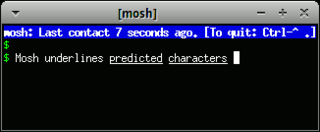Related Research Articles
Steganography is the practice of representing information within another message or physical object, in such a manner that the presence of the information is not evident to human inspection. In computing/electronic contexts, a computer file, message, image, or video is concealed within another file, message, image, or video. The word steganography comes from Greek steganographia, which combines the words steganós, meaning "covered or concealed", and -graphia meaning "writing".
The Secure Shell Protocol (SSH) is a cryptographic network protocol for operating network services securely over an unsecured network. Its most notable applications are remote login and command-line execution.

The X Window System is a windowing system for bitmap displays, common on Unix-like operating systems.

An email client, email reader or, more formally, message user agent (MUA) or mail user agent is a computer program used to access and manage a user's email.
A virtual private network (VPN) is a mechanism for creating a secure connection between a computing device and a computer network, or between two networks, using an insecure communication medium such as the public Internet. A VPN can extend a private network, enabling users to send and receive data across public networks as if their devices were directly connected to the private network. The benefits of a VPN include security, reduced costs for dedicated communication lines, and greater flexibility for remote workers. VPNs are also used to bypass internet censorship. Encryption is common, although not an inherent part of a VPN connection.

Harold Abelson is the Class of 1922 Professor of Computer Science and Engineering in the Department of Electrical Engineering and Computer Science at the Massachusetts Institute of Technology (MIT), a founding director of both Creative Commons and the Free Software Foundation, creator of the MIT App Inventor platform, and co-author of the widely-used textbook The Structure and Interpretation of Computer Programs, sometimes also referred to as "the wizard book."

A shell account is a user account on a remote server, traditionally running under the Unix operating system, which gives access to a shell via a command-line interface protocol such as telnet, SSH, or over a modem using a terminal emulator.
The Berkeley r-commands are a suite of computer programs designed to enable users of one Unix system to log in or issue commands to another Unix computer via TCP/IP computer network. The r-commands were developed in 1982 by the Computer Systems Research Group at the University of California, Berkeley, based on an early implementation of TCP/IP.

In computer networking, port forwarding or port mapping is an application of network address translation (NAT) that redirects a communication request from one address and port number combination to another while the packets are traversing a network gateway, such as a router or firewall. This technique is most commonly used to make services on a host residing on a protected or masqueraded (internal) network available to hosts on the opposite side of the gateway, by remapping the destination IP address and port number of the communication to an internal host.
In computer networks, a tunneling protocol is a communication protocol which allows for the movement of data from one network to another. It involves allowing private network communications to be sent across a public network through a process called encapsulation.
qrpff is a Perl script created by Keith Winstein and Marc Horowitz of the MIT SIPB. It performs DeCSS in six or seven lines. The name itself is an encoding of "decss" in rot-13. The algorithm was rewritten 77 times to condense it down to six lines.

In computing, a shell is a computer program that exposes an operating system's services to a human user or other programs. In general, operating system shells use either a command-line interface (CLI) or graphical user interface (GUI), depending on a computer's role and particular operation. It is named a shell because it is the outermost layer around the operating system.
Object hyperlinking is a term that refers to extending the Internet to objects and locations in the real world. Object hyperlinking aims to extend the Internet to the physical world by attaching tags with URLs to tangible objects or locations. These object tags can then be read by a wireless mobile device and information about objects and locations retrieved and displayed.
Privacy software is software built to protect the privacy of its users. The software typically works in conjunction with Internet usage to control or limit the amount of information made available to third parties. The software can apply encryption or filtering of various kinds.
This page is a comparison of notable remote desktop software available for various platforms.
Slirp is a software program that emulates a PPP, SLIP, or CSLIP connection to the Internet using a text-based shell account. Its original purpose became largely obsolete as dedicated dial-up PPP connections and broadband Internet access became widely available and inexpensive. It then found additional use in connecting mobile devices, such as PDAs, via their serial ports. Another significant use case is firewall piercing/port forwarding. One typical use of Slirp creates a general purpose network connection over a SSH session on which port forwarding is restricted. Another use case is to create external network connectivity for unprivileged containers.

OpenSSH is a suite of secure networking utilities based on the Secure Shell (SSH) protocol, which provides a secure channel over an unsecured network in a client–server architecture.
Hari Balakrishnan is the Fujitsu Professor of Computer Science and Artificial Intelligence in the Department of Electrical Engineering and Computer Science at MIT, and the Co-founder and CTO at Cambridge Mobile Telematics.

In computing, Mosh is a tool used to connect from a client computer to a server over the Internet, to run a remote terminal. Mosh is similar to SSH, with additional features meant to improve usability for mobile users. The major features are:

Lex Fridman is a Russian-American computer scientist, podcaster, and an artificial intelligence researcher. He is a research scientist at the Massachusetts Institute of Technology, and he hosts the Lex Fridman Podcast, a podcast and YouTube series.
References
- ↑ Widom, Jennifer (Summer 2014). "2014 Department Newsletter". Archived from the original on 3 September 2014. Retrieved 2 September 2014.
- ↑ Keith Winstein and Faraz Najafi named recipients of 2012 Claude E. Shannon Research Assistantships, RLE News Articles, 27 April 2012. Retrieved 2 May 2013.
- ↑ "Keith Winstein at Wireless@MIT". MIT CSAIL.
- 1 2 Vanderkam, Laura. "Hidden Meanings: Keith Winstein", Scientific American Online, 16 May 2008. Retrieved 2 May 2013.
- ↑ Chang, Ching-Yun, and Stephen Clark. "Practical linguistic steganography using contextual synonym substitution and vertex colour coding", Proceedings of the 2010 Conference on Empirical Methods in Natural Language Processing. Association for Computational Linguistics, 2010
- ↑ Bergmair, Richard. "Towards linguistic steganography: A systematic investigation of approaches, systems, and issues", Final year project, The University of Derby, April (2004). Retrieved 2 May 2013.
- ↑ Taskiran, Cuneyt M., et al. "Attacks on lexical natural language steganography systems" Archived 2016-03-04 at the Wayback Machine , Electronic Imaging 2006. International Society for Optics and Photonics, 2006.
- ↑ Clark, Stephen and Ching-Yun (Frannie) Chang. "Linguistic Steganography: Information Hiding in Text", University of Cambridge Computer Laboratory, May 2012. Retrieved 2 May 2013.
- ↑ "Mosh: the mobile shell". Retrieved on 28 March 2013.
- ↑ Brockmeier, Joe. "Into the Mosh Pit: A Mobile Shell Replacement for SSH" Archived 2014-03-20 at the Wayback Machine , linux.com, 10 April 2012. Retrieved on 28 March 2013.
- ↑ Loux, Brian. SIPB Members’ Hack Draws Legal Controversy, The Tech, 13 March 2001.
- ↑ Schwartz, John. With Cable TV at M.I.T., Who Needs Napster?, New York Times, 27 October 2003.
- ↑ Mandel, Josh; Roach, Austin; Winstein, Keith (April 2004). "MIT Proximity Card Vulnerabilities" (PDF). Archived from the original (PDF) on 6 March 2016. Retrieved 1 March 2023.
- ↑ Forelle, Charles. "Fun with Calendars", Wall Street Journal Online, 29 December 2009. Retrieved on 2 May 2013.
- ↑ Curt Nickisch (October 29, 2009). "Wall Street Journal Closes Boston Bureau, Cuts 9 Reporters". WBUR. Retrieved April 28, 2013.
- ↑ Wood, Shelley. ATLAS trial "flaws"? Wall Street Journal alleges stats do not prove noninferiority of Liberté to Taxus Express, theheart.org, 14 August 2008. Retrieved 2 May 2013.
- ↑ Wall Street Journal: Reporter reviews data, says company published flawed research analysis, Knight Science Journalism Tracker, 14 August 2008. Retrieved 15 Jan 2016.
- ↑ Winstein, Keith. "A Simple Health-Care Fix Fizzles Out", The Wall Street Journal, 11 February 2010, page A1.
- ↑ Goldberg, Carey. "Is ‘Google Flu Trends’ Prescient Or Wrong?", wbur's CommonHealth, 13 January 2013. Retrieved 2 May 2013.
- ↑ Goldberg, Carey. "As Flu Ebbs, Google Tracker Looking Way, Way Too High", wbur's CommonHealth, 4 February 2013. Retrieved 2 May 2013.